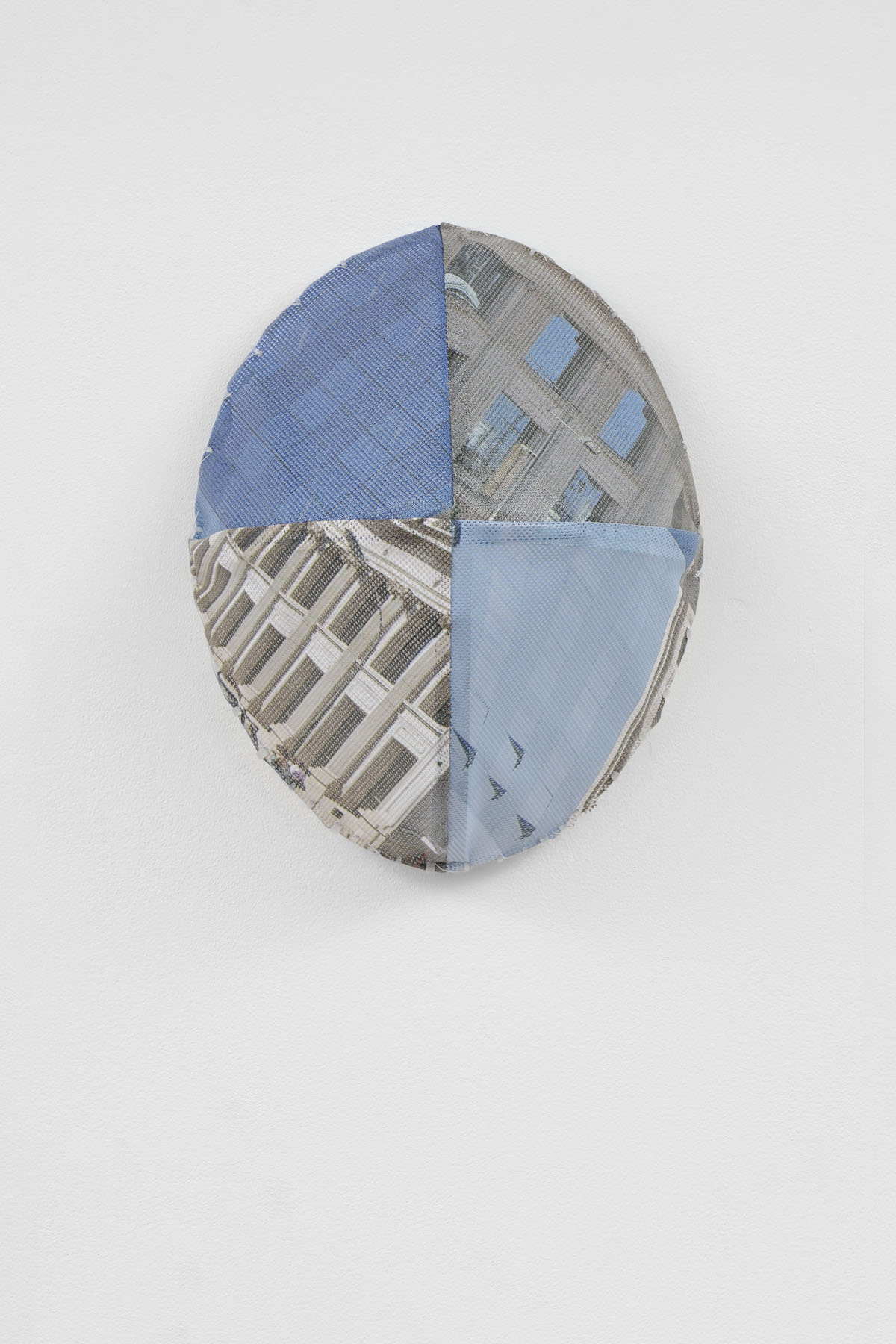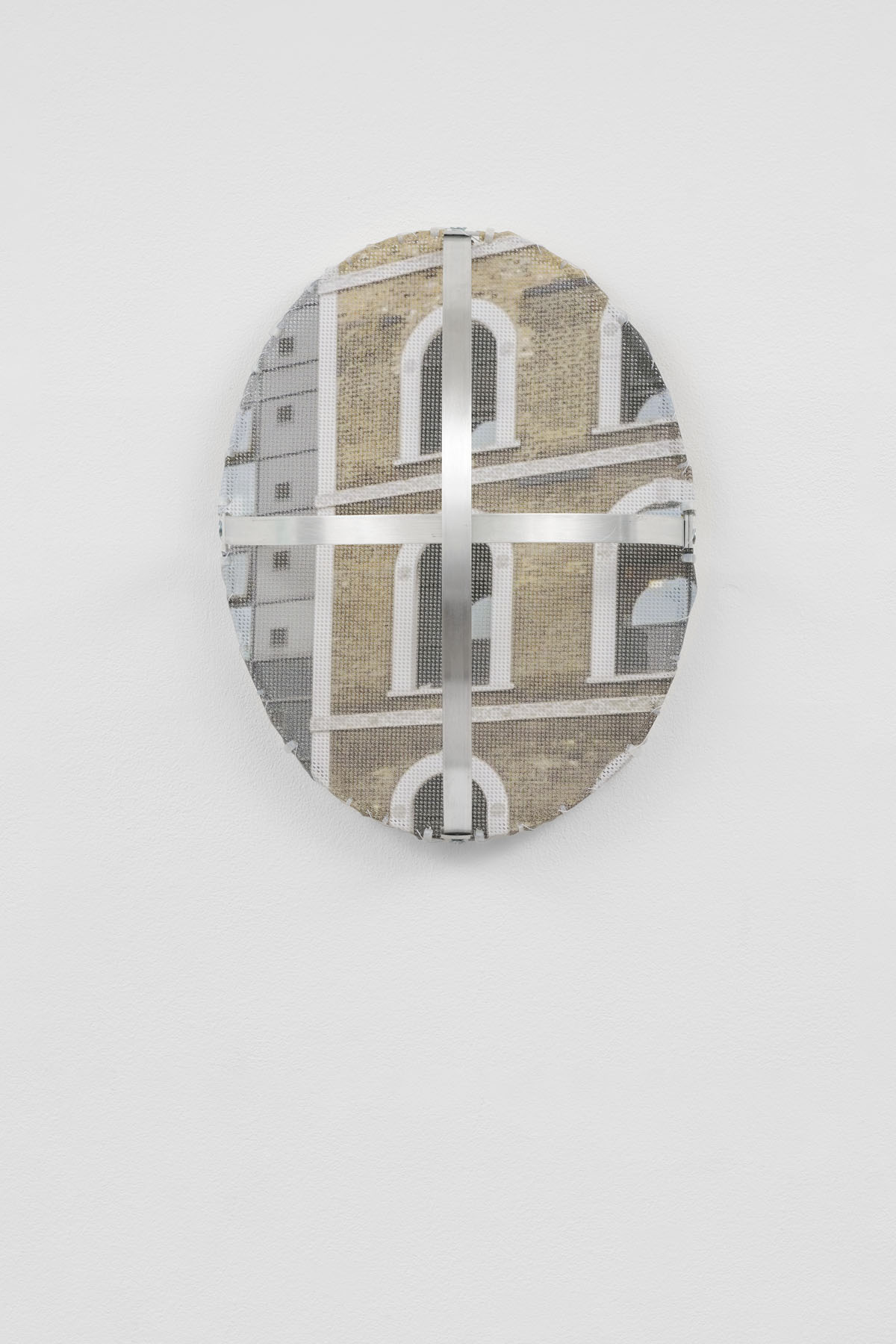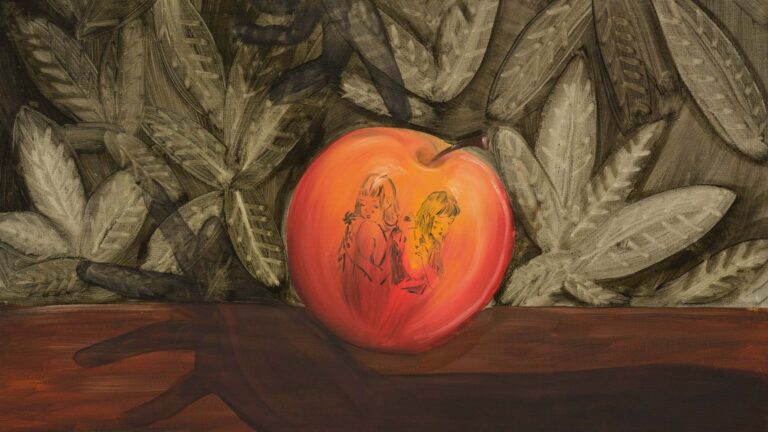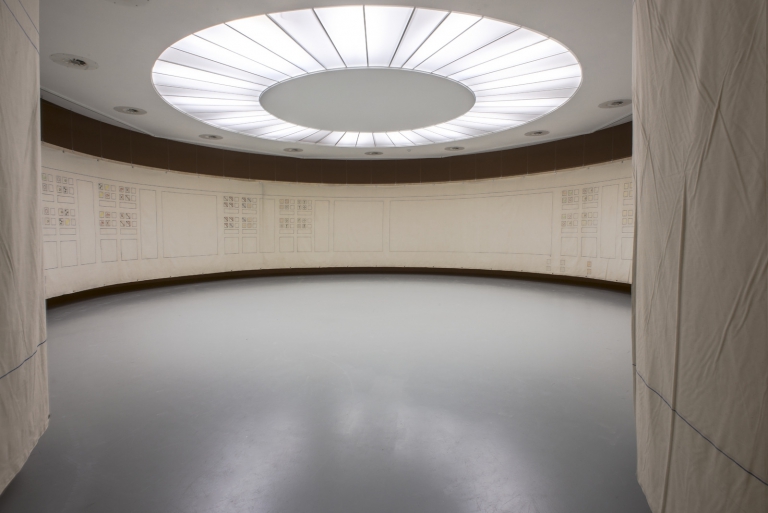Artist: Jasmin Werner
Exhibition title: Façadomy
Venue: Damien & The Love Guru, Brussels, Belgium
Date: March 7 – until further notice, 2020
Photography: all images courtesy of the artist and Damien & The Love Guru, Brussels photo: GRAYSC
17,000 years ago, a number of holes were made in the walls of the caves of Lascaux, in the South of France. Branches were stuck in the holes, serving as stable horizontal beams. Vertical beams were then attached, creating a structure that gave access to the ceiling. This is how the Lascaux caves were painted.
The ancient Greeks built scaffolds to make statues, larger than life. In the Altes Museum in Berlin there is a drinking cup from the early 5th century BC. The ‘Berlin Foundry Cup’ is painted all around with images of an ancient Greek foundry. Sculptors work on one of the statues, standing on a wooden scaffold.
We use metal scaffolds to construct our buildings. They were developed by two English brothers called Daniel and David Jones. In 1913, they built a scaffold around Buckingham Palace using their patented system, ‘Rapid Scaffixers’, to fit the metal tubes together. Their scaffolding promised change, promised progress, and stood in the way of an unobstructed view on development.
There’s no such history written of safety mesh, the netting that contemporary scaffolds are often wrapped in. Façades are wrapped in scaffolds are wrapped in mesh. The veils that shroud the work of construction in mystery.
Mesh tries to cancel the scaffold’s promise, to make it dis-appear before the work is even done. All it wants us to have is the grand reveal. It renders almost invisible and harmless the messiness of construction. Almost.
Mesh is not transparent, but it’s also not opaque. It’s a web that places itself between us and an object and makes us look at both, simultaneously. We see the building behind the scaffold’s sharp lines through the mesh; the veil and its objects becoming one.
In the late 19th century, widows concealed their faces behind a mesh called ‘Courtauld crape’, named after its main manufac-turer: Courtaulds from England. Crape was a matte gauze made of waste silk, crimped with heated rollers, then dyed black and stiffened with starch or glue.
Strict mourning etiquette forbade all colors but black and dictated widows to wear crape veils over their faces whenever in public, for up to four years after their husbands had passed away. For the prescribed duration of the process of mourning, the widow had no choice but to present herself to the outside world as a colorless image reminiscent of the past. Like a clas-sical façade against a rapidly modernizing backdrop, she stood out from her surroundings, performing an apparent nostalgia for times since gone.
Some women called crape ‘a veritable instrument of torture’ because, apart from this emotional labor, it was costly, kind of heavy and unpleasant. It caused irritation to the eyes and skin and stained the face when wet or damp.
“Many a woman has been laid in her coffin by the wearing of crape,” a doctor wrote by the end of the 19th century. It’s true that inhaling its poisonous particles was known to have caused death. But despite all this, the obscuring mesh supposedly served a noble cause: to protect the widow against “the untimely gayety of a passing stranger.”
Like the veil protecting the widow, mesh protects building and builders from the gaze of the outside world. And yet it seems made rather for that outside world, protecting it from falling rub-ble, and substituting the view on reconstruction with a promise of the reconstructed. As if that passing stranger couldn’t already recognize the widow, behind that blackest of black surfaces.
What if the veil actually served to protect the outside world from the widow? We enjoy the stability and permanence of nostalgic façades, not the instability of the ruins behind them. Mourning makes us uncomfortable, we prefer not to see the widow’s grief. But what if we invert the gaze and look back at the world? What did she see through the mesh?
“What a dark, ugly thing it is!” said Amy, unfolding and throwing it over her head; “how dismal it must be to see the world through such a veil as this!”
“And yet till one has seen the world through a veil like that, one has never truly lived,” said another voice, joining in the conversation.
from ‘The Mourning Veil’
by Harriet Beecher Stowe
Michiel Huijben
Jasmin Werner, Façadomy, 2020, exhibition view, Damien & The Love Guru, Brussels
Jasmin Werner, Façadomy, 2020, exhibition view, Damien & The Love Guru, Brussels. Sound here. Indoor architecture tour in reference to the works of the exhibition by Olaf Winkler. Architectural journalist, artist and architecture guide. Schwerte / Brussels. The audio guide was recorded due to the current circumstances, as the actual architectural tours could not take place in the gallery.
Jasmin Werner, Façadomy, 2020, exhibition view, Damien & The Love Guru, Brussels
Jasmin Werner, Façadomy, 2020, exhibition view, Damien & The Love Guru, Brussels
Jasmin Werner, Façadomy, 2020, exhibition view, Damien & The Love Guru, Brussels
Jasmin Werner, Façadomy (EU headquarters, Brussels), 2020, printed mesh fencing, aluminium, zip ties, thread, synthetic hairmask : 32 x 20 x 60 cmaluminium stand : 184 x 12 x 12 cm. Sound here. Indoor architecture tour in reference to the works of the exhibition by Olaf Winkler. Architectural journalist, artist and architecture guide. Schwerte / Brussels. The audio guide was recorded due to the current circumstances, as the actual architectural tours could not take place in the gallery.
Jasmin Werner, Façadomy, 2020, exhibition view, Damien & The Love Guru, Brussels
Jasmin Werner, Façadomy (EU headquarters, Brussels), 2020, printed mesh fencing, aluminium, zip ties, thread, synthetic hairmask : 32 x 20 x 60 cmaluminium stand : 184 x 12 x 12 cm. Sound here. Indoor architecture tour in reference to the works of the exhibition by Olaf Winkler. Architectural journalist, artist and architecture guide. Schwerte / Brussels. The audio guide was recorded due to the current circumstances, as the actual architectural tours could not take place in the gallery.
Jasmin Werner, Façadomy, 2020, mesh fencing, aluminium, zip ties, thread, synthetic hair, 32 x 20 x 53 cm.
Jasmin Werner, Façadomy (Wallonie-Bruxelles International, Brussels), 2020, printed mesh fencing, aluminium, zip ties, thread, 32 x 20 x 61 cm. Sound here. Indoor architecture tour in reference to the works of the exhibition by Olaf Winkler. Architectural journalist, artist and architecture guide. Schwerte/Brussels. The audio guide was recorded due to the current circumstances, as the actual architectural tours could not take place in the gallery.
Jasmin Werner, Façadomy, 2020, mesh fencing, aluminium, zip ties, thread, 32 x 20 x 58 cm
Jasmin Werner, Façadomy, 2020, mesh fencing, aluminium, zip ties, thread, synthetic hair, 32 x 20 x 62 cm
Jasmin Werner, Façadomy (Compañía Sudamericana de Vapores Valparaiso, Chile), 2020, printed mesh fencing, aluminium, zip ties, thread, 32 x 20 x 58 cm. Sound here. Indoor architecture tour in reference to the works of the exhibition by Olaf Winkler. Architectural journalist, artist and architecture guide. Schwerte / Brussels. The audio guide was recorded due to the current circumstances, as the actual architectural tours could not take place in the gallery.
Jasmin Werner, Façadomy, 2020, mesh fencing, aluminium, zip ties, thread, 32 x 20 x 58 cm
Jasmin Werner, Façadomy (Dom Römer, Frankfurt), 2020, printed mesh fencing, aluminium, zip ties, thread, 32 x 20 x 58 cm. Sound here. Indoor architecture tour in reference to the works of the exhibition by Olaf Winkler. Architectural journalist, artist and architecture guide. Schwerte / Brussels. The audio guide was recorded due to the current circumstances, as the actual architectural tours could not take place in the gallery.
Jasmin Werner, Façadomy (Hearst Tower, New York ), 2020, printed mesh fencing, aluminium, zip ties, thread, synthetic hair, 32 x 20 x 58 cm. Sound here. Indoor architecture tour in reference to the works of the exhibition by Olaf Winkler. Architectural journalist, artist and architecture guide. Schwerte / Brussels. The audio guide was recorded due to the current circumstances, as the actual architectural tours could not take place in the gallery.
Jasmin Werner, Façadomy (New Hall UCL, London), 2020, printed mesh fencing, aluminium, zip ties, thread, 32 x 20 x 58 cm. Sound here. Indoor architecture tour in reference to the works of the exhibition by Olaf Winkler. Architectural journalist, artist and architecture guide. Schwerte / Brussels. The audio guide was recorded due to the current circumstances, as the actual architectural tours could not take place in the gallery.
Jasmin Werner, Façadomy (Dom Römer, Frankfurt), 2020, printed mesh fencing, aluminium, zip ties, thread, synthetic hair, 32 x 20 x 59 cm. Sound here. Indoor architecture tour in reference to the works of the exhibition by Olaf Winkler. Architectural journalist, artist and architecture guide. Schwerte / Brussels. The audio guide was recorded due to the current circumstances, as the actual architectural tours could not take place in the gallery.
Jasmin Werner, Façadomy (Wallonie-Bruxelles International, Brussels), 2020, printed mesh fencing, aluminium, zip ties, thread, 32 x 20 x 58 cm. 32 x 20 x 58 cm
Sound here. Indoor architecture tour in reference to the works of the exhibition by Olaf Winkler. Architectural journalist, artist and architecture guide. Schwerte / Brussels. The audio guide was recorded due to the current circumstances, as the actual architectural tours could not take place in the gallery.

























